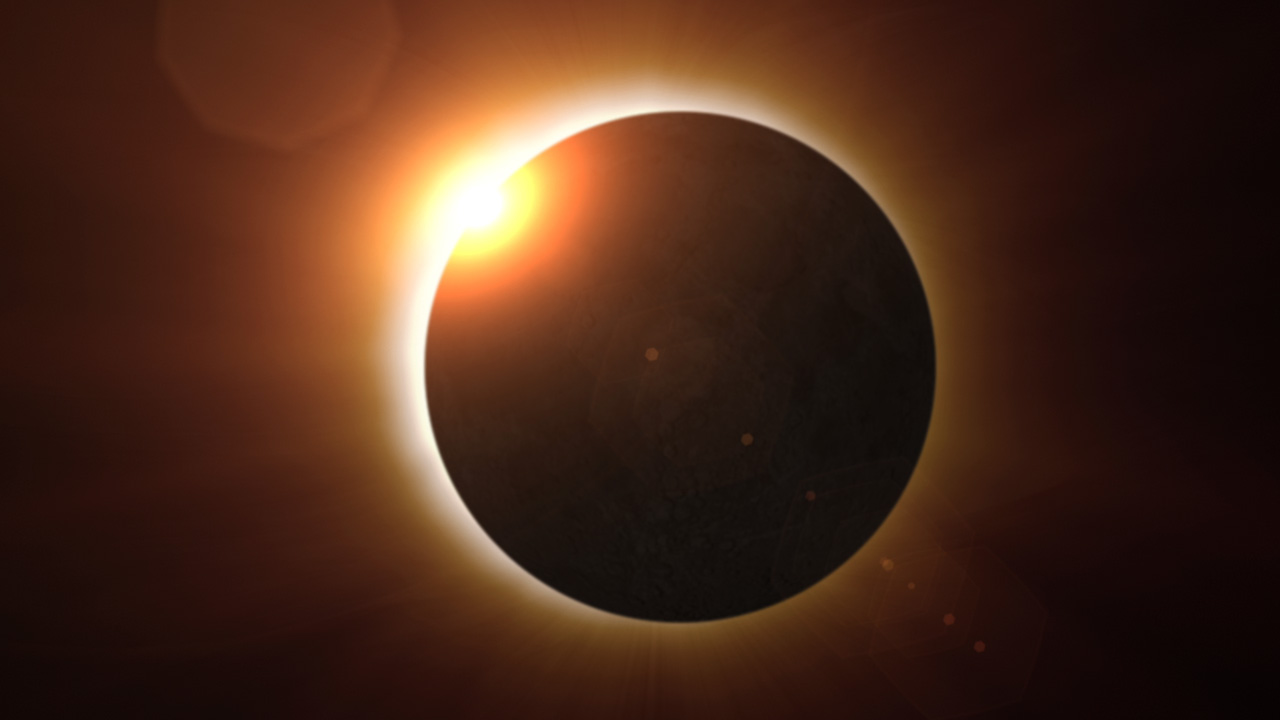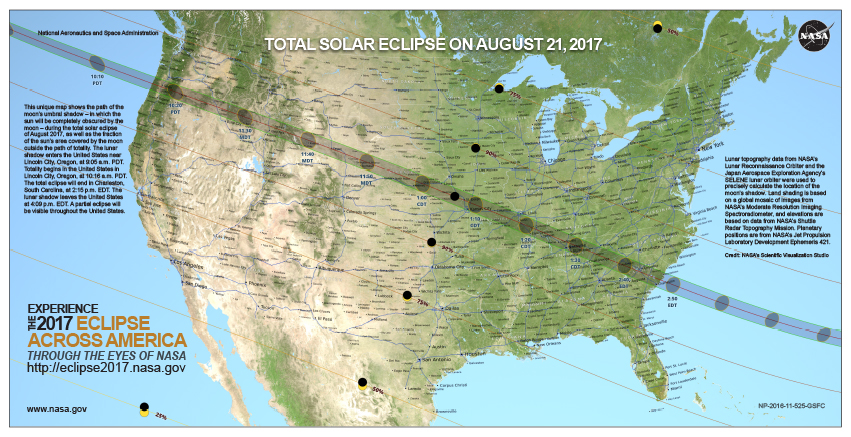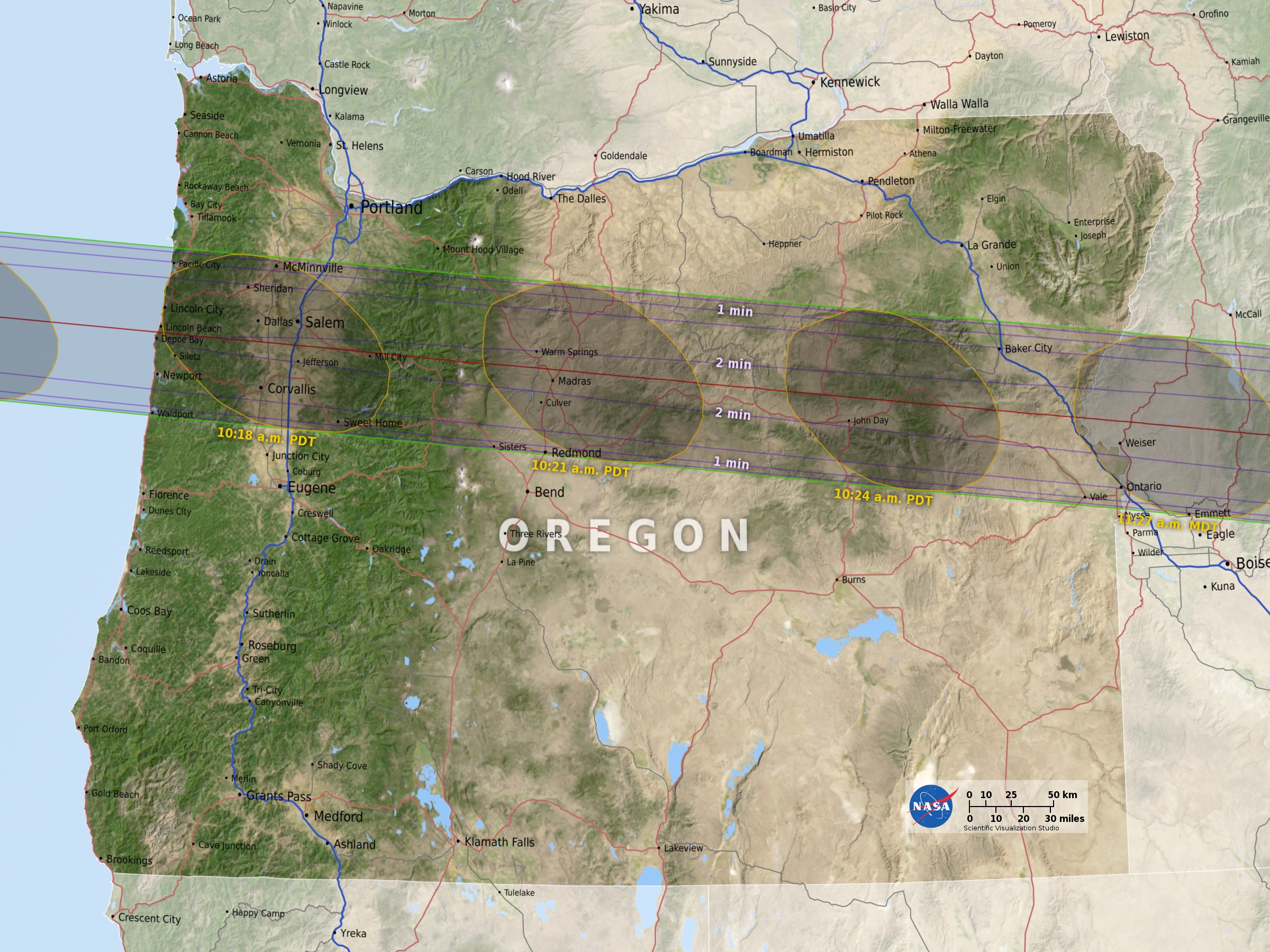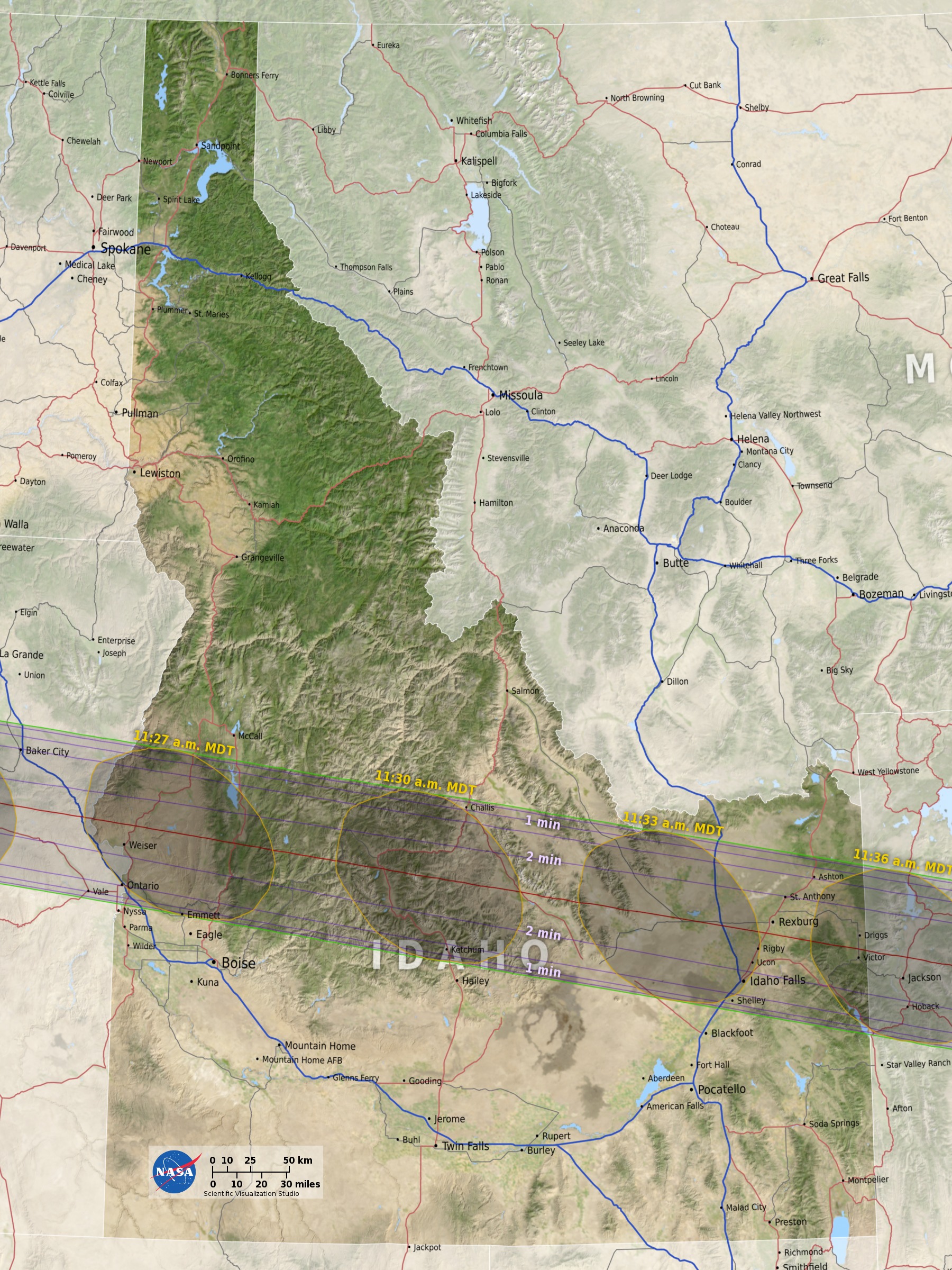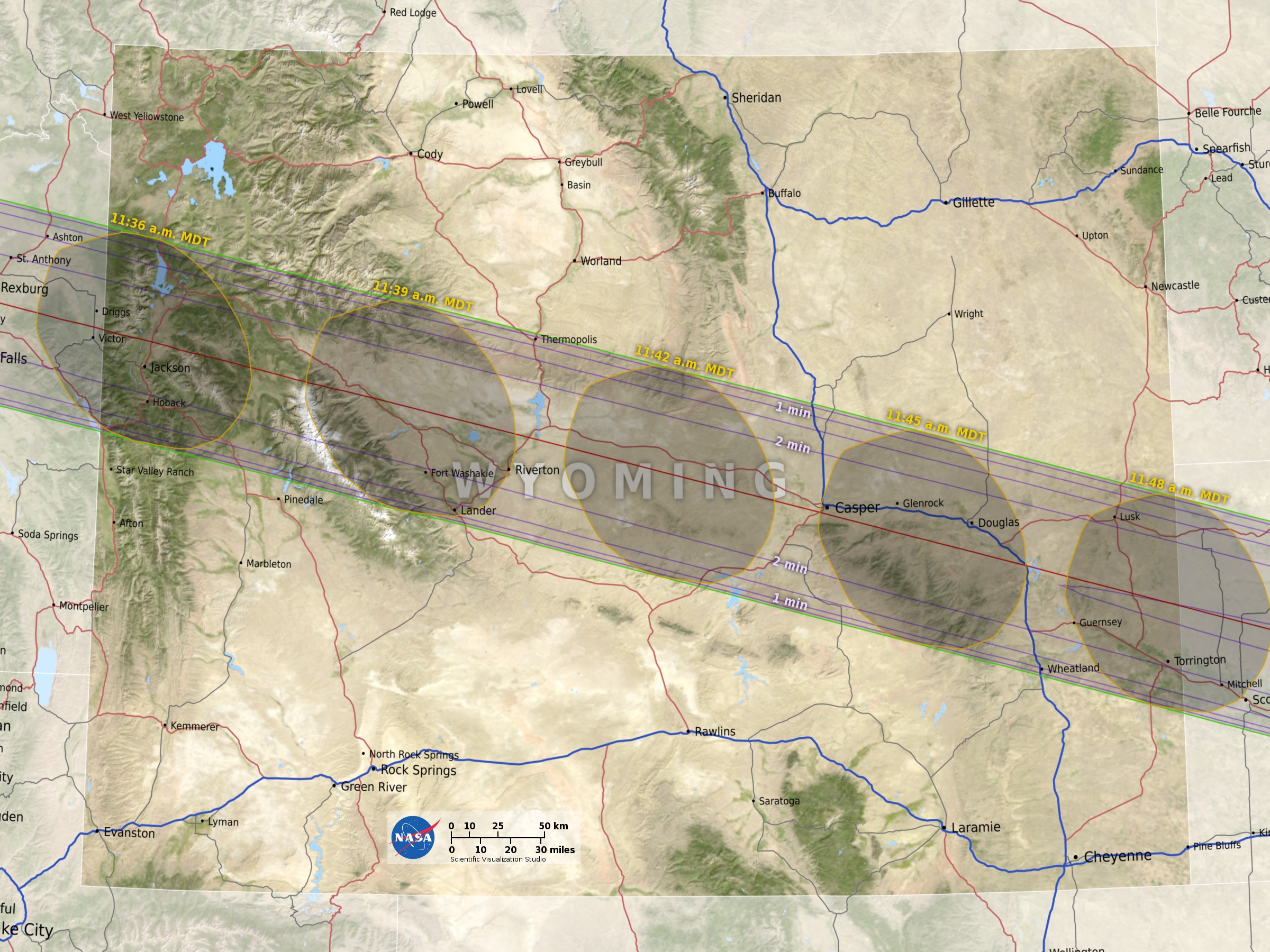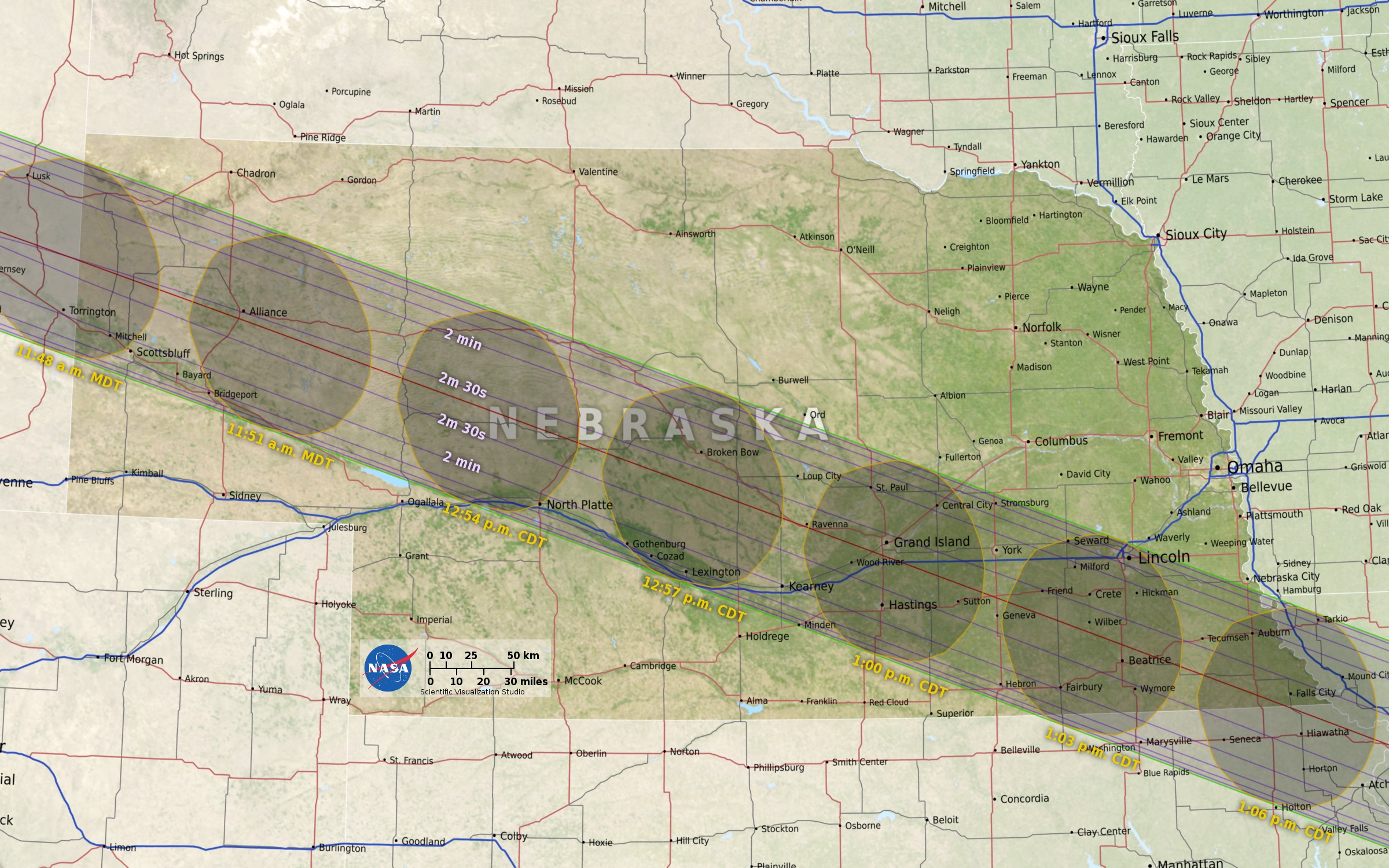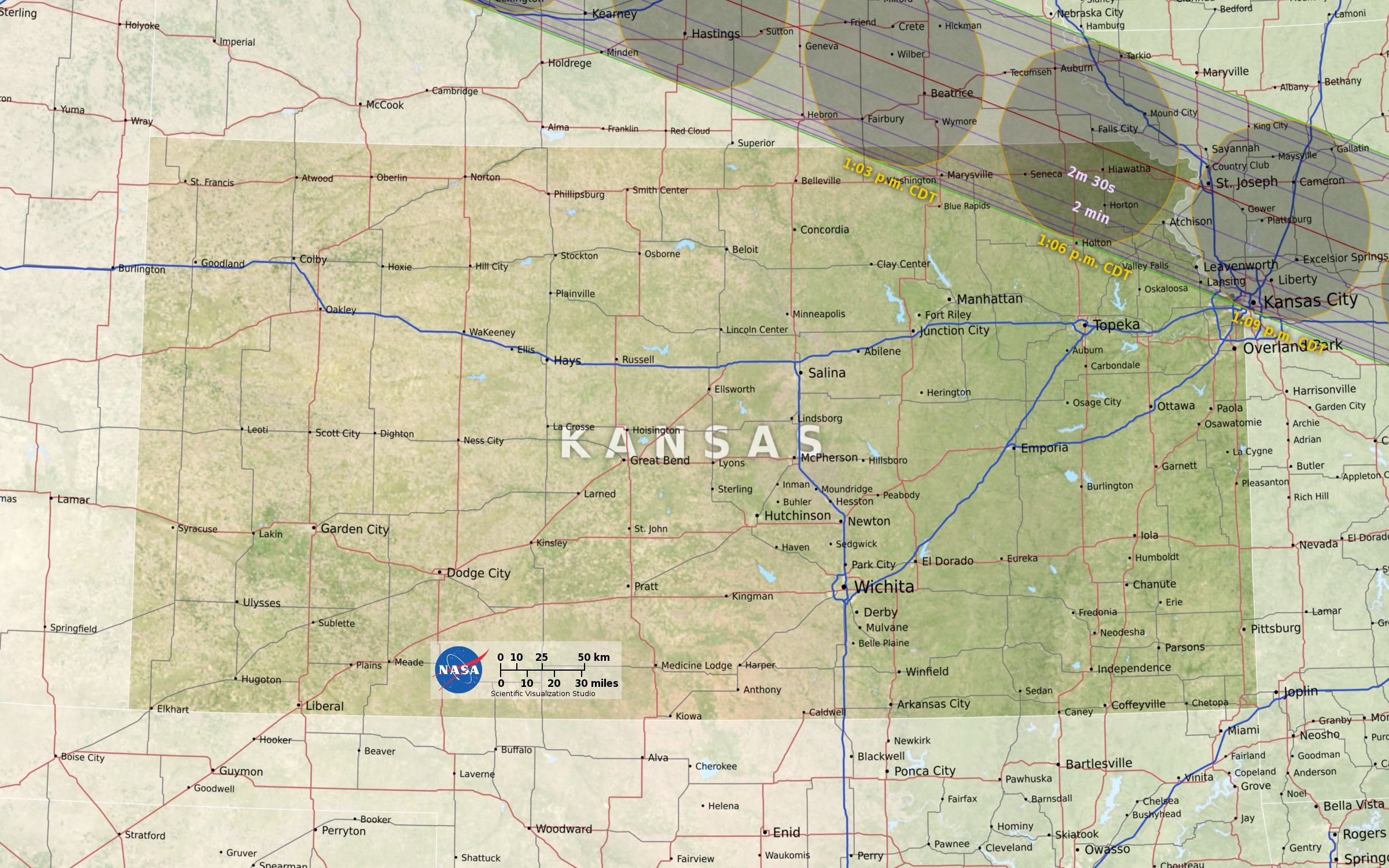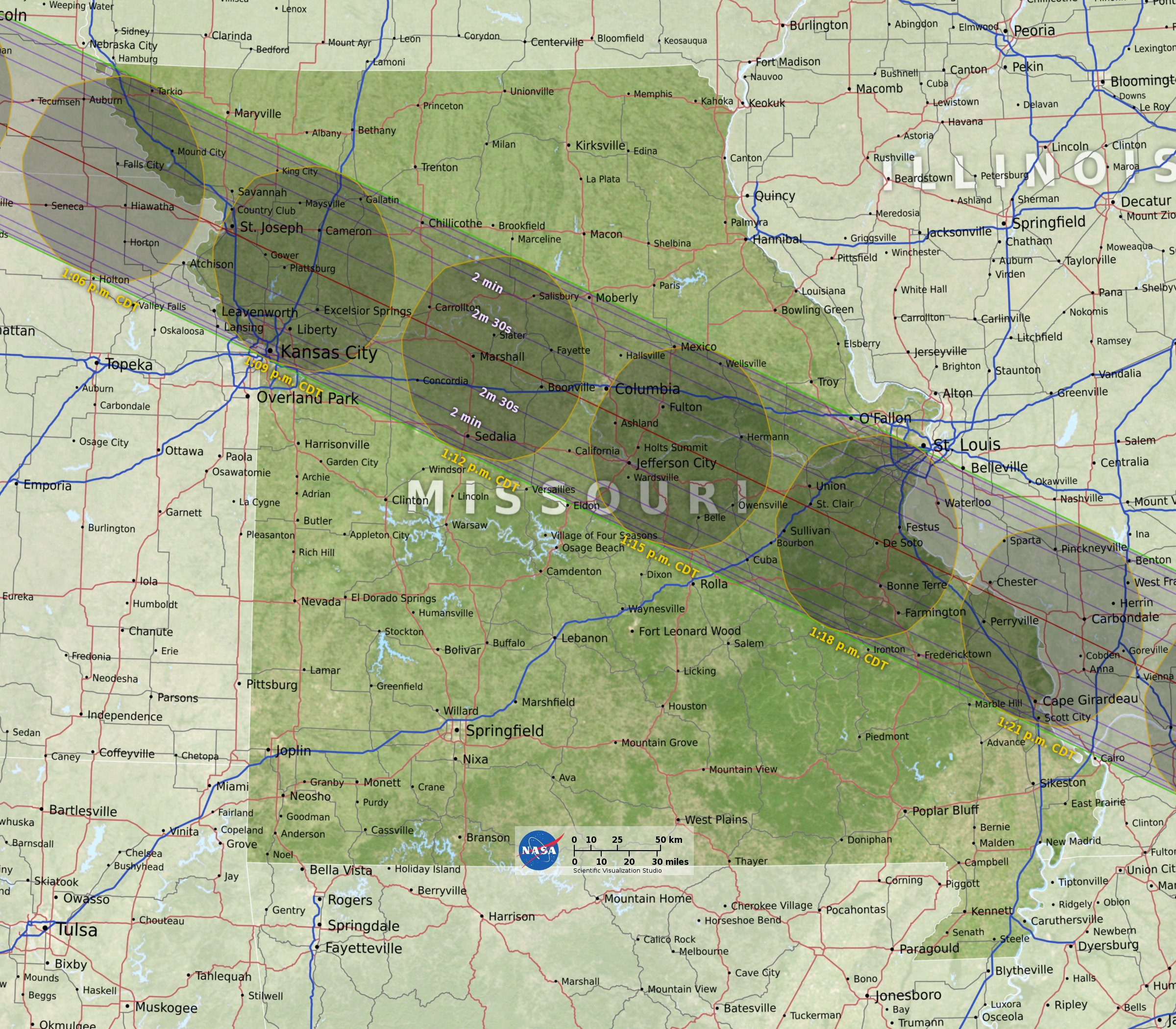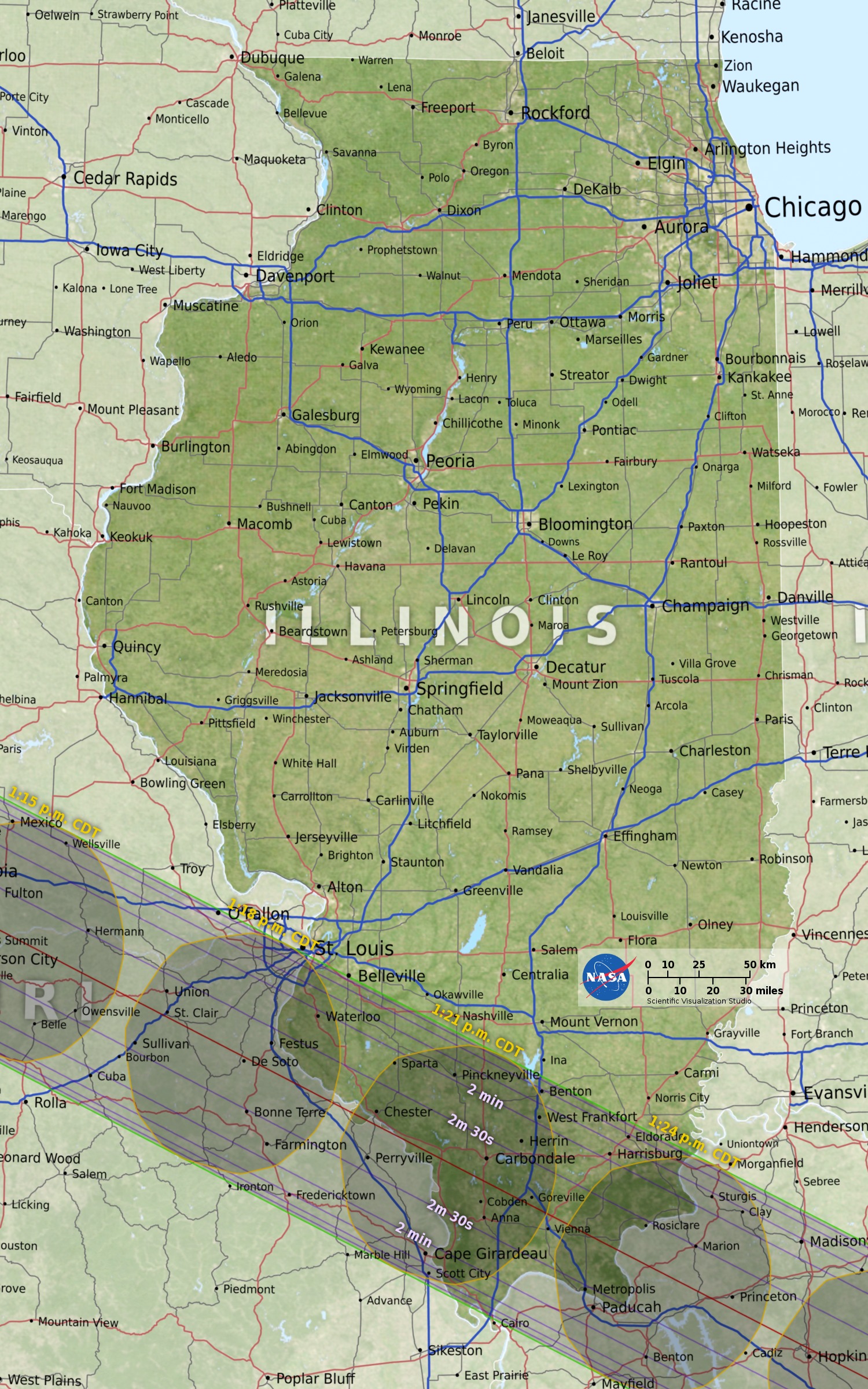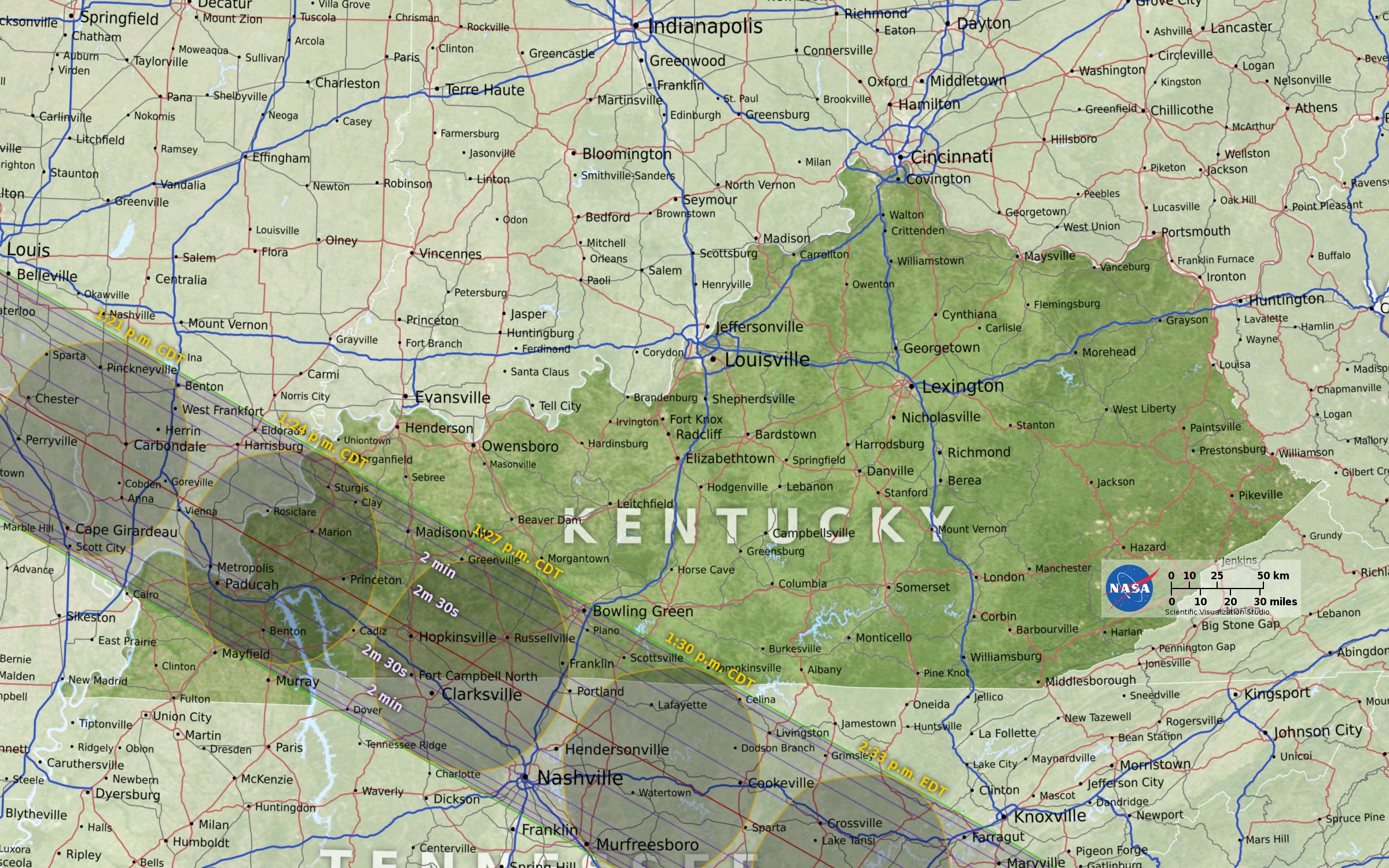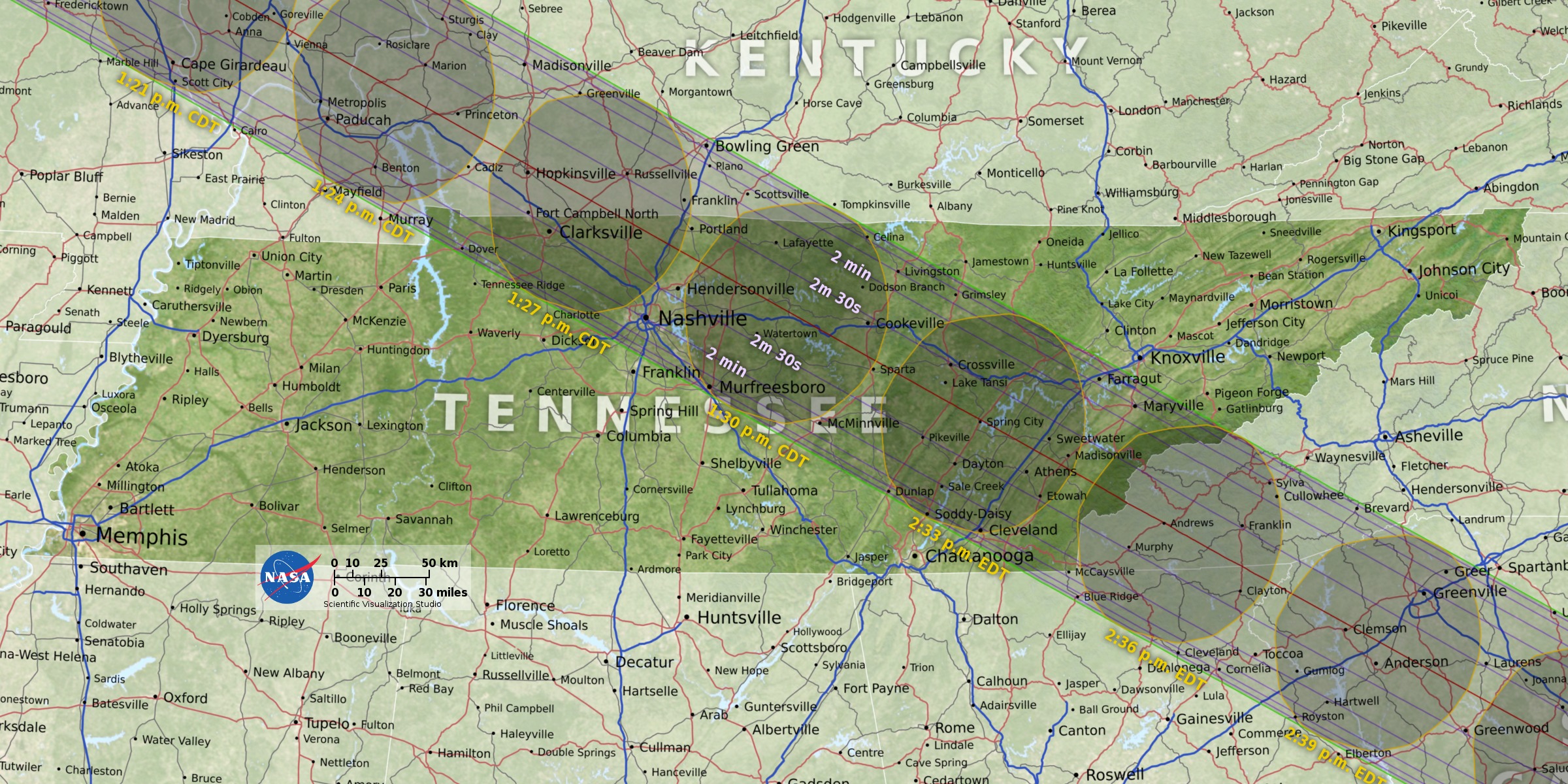Where to See the 2017 Total Solar Eclipse, State by State
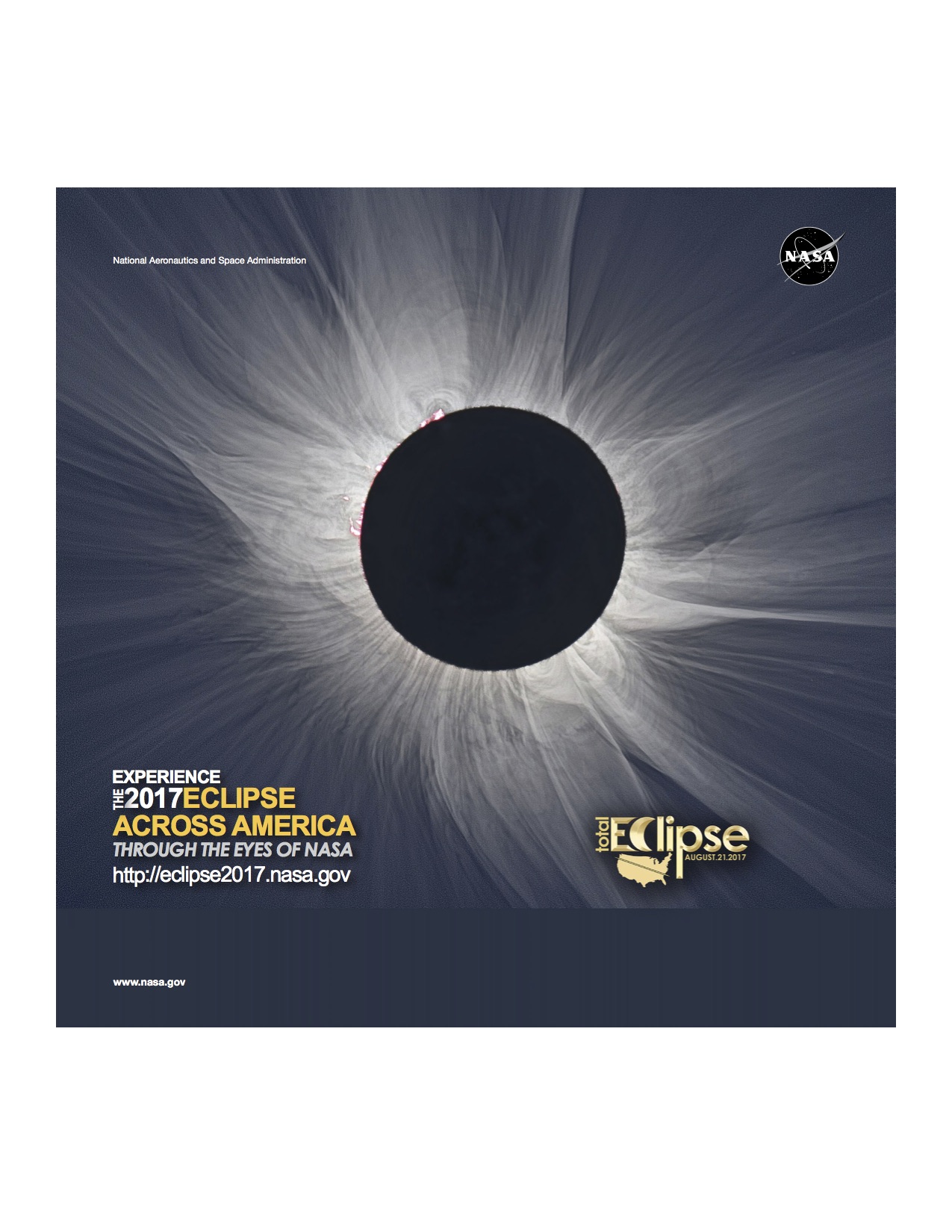
Introduction
On Aug. 21, a total solar eclipse will be visible from the contiguous United States for the first time since 1979. Sky watchers in North America and Hawaii will be able to see at least a partial solar eclipse on that summer day, but most people will have to travel to see the sun completely eclipsed by the moon. If you're considering making a trip to see the total solar eclipse, here's a guide to which states and cities fall inside the path. And remember that a trip to see the eclipse could also include stops at a few local attractions.
To quote noted astronomer and science communicator Neil deGrasse Tyson, "A total eclipse of the sun belongs on everyone's bucket list." Although many people have likely had the opportunity to view a total eclipse of the moon (since those are visible over a larger area than a total solar eclipse), few people have been lucky enough to see a darkened sun adorned with the soft pearly white halo of the sun's corona — solar gases streaming millions of miles into interplanetary space — that blossoms briefly during totality. For any spot of land on Earth, there's an oft-cited average time of 375 years between total solar eclipses. That varies greatly, of course, but it emphasizes the general rarity of these events. [Total Solar Eclipse 2017: When, Where and How to See It (Safely)]
Any one person's chances of witnessing a totally eclipsed sun without traveling far from home are quite small — the "path of totality" of a solar eclipse is rather narrow, so many total eclipses are visible only from remote parts of the globe. But those odds will be considerably increased late this summer for an estimated 225 million people who live within a one-day's drive of the path (averaging about 70 miles wide) of the moon's dark shadow as it sweeps from one end of the United States to the other.
On that third Monday of next August, the sun will appear to be partially obscured by the moon to viewers across all of North America and in Hawaii. Just how much of the sun will be eclipsed by the moon will depend on where you're observing from. For most people in the U.S., the moon will appear to cover at least two-thirds of the sun and in many locations it will be much more than that. Viewers located very close to the path of totality will see only a sliver of the sun remaining. If that’s the case, then most definitely you should try to make an effort to get yourself into the totality path!
This is the first time a total solar eclipse has gone from one American coast to the other since 1918. It will also be the first time in U.S. history that a total solar eclipse will make landfall exclusively on U.S. soil, meaning it will not be visible from any other country. (This technically happened in 1257 — but, of course, the United States wasn't a country way back then.)
For that reason, some are calling this upcoming celestial event the "Great American Eclipse."
So let's concentrate on those places that will be inside the path of totality.
Breaking space news, the latest updates on rocket launches, skywatching events and more!
The Shadow's Path
The dark shadow of the moon — the umbra — will first touch the Earth's surface far out over the North Pacific Ocean, nearly 1,000 miles south of Alaska's Aleutian Islands, at 9:48 a.m. local time. For 27 minutes, the umbra will sweep rapidly to the east over the ocean.
Finally, the umbra will arrive along the coast of Oregon at 10:15 a.m. local time.
From there, the moon's shadow is going to race from coast to coast across the United States. That's a distance of almost 2,500 miles, from Oregon to South Carolina,and it will take the umbra just 94 minutes to travel that distance.
That works out to nearly 27 miles per minute (43 km/minute), or about 1,600 mph (2,574 km/h) — about three times faster than a commercial jetliner.
That's why, along the path of totality, the sun will appear completely covered for no more than 160 seconds.
Now, let's take an imaginary trip and follow the moon's dark shadow as it rushes across the country.
We will travel from state to state, visiting a few of the interesting places that will have a chance to experience the eerie effect of daytime darkness that accompanies a total solar eclipse.
I will also mention some places that are located just outside the total eclipse path. If you live in one of these places, please take our advice and make every effort to position yourself somewhere inside the total eclipse path instead.
Understand that even with 99 percent of the sun covered, the slightest sliver of sunlight that remains will spoil the spectacular effects that you can only get from a total eclipse.
So make an effort to get yourself inside the path!
Let's start with the first state that the shadow will visit: Oregon.
Oregon
The moon's dark shadow will move across the Beaver State between 10:15 and 10:27 a.m. PDT. About 1.1 million people live within the path of totality in Oregon.
If you're interested in seeing more than just the eclipse during your visit, the Columbia River Gorge National Scenic area and Crater Lake National Park are considered to be among the top tourist attractions in the state. Schedule your visits before or after the eclipse, however, as both places are outside the totality zone.. The state's capital city, Salem, is the third largest city in Oregon and will see the sun go into total eclipse for 1 minute and 54 seconds, beginning at 10:17 a.m. Unfortunately, Oregon's largest city, Portland, will get an "almost total" eclipse. At its peak, 99.3 percent of the sun will be covered at 10:19 a.m. local time. The daylight will get quite dim, but the full effect of totality will be lost. Soooo close….
Idaho
The Gem State will see the moon's dark shadow brush on through between 11:24 and 11:36 a.m. local time (MDT). About 301,000 people who live in the umbra's path will be treated to the sight of the totally eclipsed sun. The largest city that will experience totality will be Idaho Falls. This city is a wonderful place to visit because it's close to Yellowstone and Grand Teton national parks, and Jackson Hole valley. In addition, people from far and wide come to Idaho Falls to fish in the nearby Snake River. Idaho Falls has been named as one of the "Top 100 Cities" in the U.S., and one of the "100 Best Adventure Towns." Totality arrives here at 11:32 a.m. and will last 1 minute and 47 seconds. Idaho's capital city of Boise will barely miss out on a total eclipse, with 99.5 percent of the sun hidden at 11:27 a.m.. Too bad.
Wyoming
The moon's shadow will take 15 minutes to cut across Wyoming, beginning at 11:34 a.m. local time (MDT). Here, about 175,000 people live along the path of totality. Unfortunately, one of the state's biggest tourist draws, Yellowstone National Park, lies almost entirely outside the path of totality. The total eclipse will be visible very briefly in the very southwestern corner of the park in Idaho and Wyoming, (the path of totality extends, at most, about 800 meters into the park). But Grand Teton National Park is completely within the dark shadow's path. The park is a very popular place to hike, fish, camp and climb mountains. At the Jackson Hole Airport, totality begins at 11:34 a.m. and lasts 2 minutes and 20 seconds.
The sun will also become completely covered for 2 minutes and 25 seconds, beginning at 11:42 a.m. local time, from Casper, Wyoming's second largest city.
Wyoming is also where you will find the point of highest elevation in the total eclipse path: Gannett Peak, which stands 13,809 feet — more than 2.5 miles high. Some adventurous folks might want to watch the eclipse from the top of this mountain, but here is a warning: getting there will be tough. Even experienced mountain climbers say it can take from three to five days to reach the summit. Mountaineering skills are required; this peak is not recommended for amateur hikers. Totality will begin at 11:36 a.m. local time and will last 2 minutes and 2 seconds.
Nebraska
The moon's umbra will take 21 minutes to slice across the Cornhusker State. The eclipse will last from 12:46 p.m. to 1:07 p.m. Central Daylight Time (note that the western portion of the state is located in the Mountain time zone). About 590,000 people live within the eclipse path. The state's capital of Lincoln will get 1 minute and 26 seconds of midday darkness beginning at 1:02 p.m. CDT. But even better will be the 2 minutes and 34 seconds of totality that the city of Grand Island will see, starting at 12:58 p.m. CDT. The Nebraska State Fair is held there in late August, but this year it won't begin until Aug. 25, four days after the eclipse. Nebraska's largest city, Omaha, is just outside the eclipse track: At 1:04 p.m. all but 2 percent of the sun will be covered. That's impressive, but it's still not a total eclipse.
Kansas
Only the far northeast corner of the Sunflower State will be touched by the moon's dark shadow. That happens between 1:02 and 1:09 p.m. local time (CDT). About 110,000 people in the state live within the zone of totality. The middle of the shadow path crosses through Brown and Doniphan counties, where totality will last for up to 2 minutes and 38 seconds. Farther south, the city of Atchison will be plunged into darkness for 2 minutes and 18 seconds, beginning at 1:06 p.m. local time. But the most unusual situation involves Kansas City, where the southern edge of the shadow will cut the city in half. At 1:08 p.m., if you're on the city's south side, 99.9 percent of the sun will be covered, leaving only a very small, bright segment shining through. Landmarks such as Kensington Park, City Park, Clifton Park and Donnelly College will see this, while places farther to the north will be tucked just inside the umbra and for a very short time will see a total eclipse. At Big Eleven Lake, the sun will be completely covered for 24 seconds. At Westheight Park, it's 25 seconds; Klamm Park, 37 seconds; Parkwood Park, 49 seconds; and at Roswell Park, totality will last 54 seconds.
At 1:07 p.m., the shadow will bring 90 seconds of midday darkness to the city of Leavenworth (pop. 3,600), notable as the location of several prisons, particularly the United States Disciplinary Barracks and the United States Penitentiary ("The Big House"). Talk about a "captive audience!"
Missouri
The moon's dark shadow will cut diagonally across the Show Me State between 1:04 and 1:22 p.m. local time (CDT). Interestingly, the shadow will just graze Missouri's two largest cities, Kansas City and Saint Louis, cutting both about in half.
Across Missouri, there are more than 3 million people who live inside the path of totality and about 2.6 million who live within the metropolitan areas of Kansas City and Saint Louis.
From Kansas City, the peak comes between 1:07 and 1:08 p.m. local time. Places on the city's south side such as Swope Park, Raytown and Kaufman Field, all lie just outside the track of the shadow, with 99.9 percent coverage. The actual edge of the shadow should pass between the Kansas City Convention Center and the Kaufmann Center for the Performing Arts. As you continue north, you'll move into the path of totality. From the Kansas City Downtown Airport, a 45-second total eclipse will be visible. From Dagg Park, totality will last 1 minute, 7 seconds; from Gladstone, 1 minute and 37 seconds, and from the Kansas City International Airport, the sun will go dark for 1 minute and 50 seconds.
On the other side of the state, the shadow will slice partway across the city of Saint Louis between 1:17 and 1:18 p.m. local time (CDT). In this case, however, it will be better if you head south, not north. Unfortunately, downtown Saint Louis will be just outside the eclipse track. Such famous landmarks as Busch Stadium, the Gateway Arch, Saint Louis Zoo and Lambert Airport will all come within a whisker of a total eclipse with 99.9 percent coverage. The edge of the shadow will cut across Forest Park.
From The Hill at Berra Park, totality will last 33 seconds; Bevo sees 59 seconds; and South Saint Louis Square will get 1 minute and 19 seconds of daytime darkness.
Kansas City and Saint Louis are connected by Interstate Highway 70. Most of this highway is within the path of totality. The city of Columbia is almost exactly in between Kansas City and Saint Louis and will get 2 minutes and 36 seconds of total eclipse, beginning at 1:12 p.m. local time. Jefferson City, the state capital, will also experience totality, seeing 2 minutes and 28 seconds, starting at 1:13 p.m.
And right along a bend in the Mississippi River is the city of Cape Giradeau, where darkness will fall at 1:20 p.m. and last for 1 minute and 44 seconds.
Illinois
Most of the Prairie State lies outside the eclipse path, but its far southern end lies within the band of total darkness where, from 1:18 to 1:24 p.m. local time (CDT), about 665,000 people will be treated to the big show in the sky. The city of Cairo is practically in the eclipse track, lying only a few miles south of the edge of the moon's dark shadow, so it's possible for viewers to walk into totality! Just head north on Sycamore Street (which is also U.S. Route 51/Ohio River Scenic Byway) until you arrive in Future City, which is just inside the southern edge of totality. Keep heading north and the length of the total eclipse will gradually increase.
The city of Carbondale is near the middle of the eclipse path and at 1:20 p.m. local time will see the sun go out for 2 minutes and 37 seconds. About 15 miles east of Carbondale is Marion, where the darkness in daytime will last for 2 minutes and 27 seconds.
Not far to the south of Carbondale is Giant City State Park, a place of breathtaking natural beauty and a sure delight for visitors of all ages. From camping and horseback riding to fishing and rappelling, it's an outdoor lover's paradise, and best of all, it is right in the middle of the path of totality and just a stone's throw from the Blue Sky Vineyard. At 1:20 p.m. local time, the total eclipse will begin and last for 2 minutes and 40.2 seconds, which is the longest duration of totality for this eclipse.
Chicago, meanwhile, lies well beyond the zone of totality. The best that anyone in the Windy City can hope to see is about 87 percent coverage at 1:19 p.m.
Kentucky
The shadow will cross through the southwest part of the Bluegrass State between 1:22 and 1:30 p.m. local time (CDT). About 590,000 people live inside the zone of total eclipse, but what makes Kentucky so special is that a spot between the towns of Princeton and Hopkinsville — along Cerulean Hopkinsville Road (Route 624) and just to the east of the intersection with J Stewart Cemetery Road — is where astronomers predict that the point of "greatest eclipse" will occur. That's where the axis of the moon's dark shadow cone passes closest to the Earth's center. Here, totality will last 2 minutes and 40.1 seconds, beginning at 1:24 p.m. CDT. That's about 40 seconds longer than the Kentucky Derby! Meanwhile, about 45 miles to the west, the city of Paducah will experience 2 minutes and 20 seconds of totality, starting at 1:22 p.m. CDT. Five minutes later, Bowling Green will watch the sun wink out for 1 minute and 27 seconds. It is too bad that Kentucky's largest city, Louisville, lies outside of the path of totality. It will see 95.8 percent of the sun eclipsed at 2:27 p.m. Eastern Daylight Time.
Tennessee
The Volunteer State is interesting because, like Kentucky, it crosses over two time zones. The western half of the state observes Central Daylight Time, while the eastern half observes Eastern Daylight Time. The moon's umbra will take 11 minutes to cut across the central and eastern half of the state, entering Tennessee at 1:25 p.m. Central time and leaving it at 2:38 p.m. Eastern time. About 2.1 million people located in the path of totality will be fortunate to have the rare sight of a total eclipse of the sun delivered to their front doors. Within the totality path are two places of special note. Clarksville, the ninth-fastest growing city in the United States, and whose nickname is Tennessee's Top Spot, will see the moon's shadow darken its skies for 2 minutes and 17 seconds, beginning at 1:25 p.m. CDT. And then, 2 minutes later, the shadow will visit the capital city of Nashville, known as Music City USA, because it is recognized as the home of country music. Major attractions here include the Grand Ole Opry and The Country Music Hall of Fame. Here, totality will last for 1 minute and 54 seconds.
Unfortunately, out of Tennessee's four biggest cities, only Nashville will witness a total eclipse. The largest city, Memphis, will see 93.2 percent of the sun covered at 1:22 p.m. CDT; Chattanooga will get 99.5 percent coverage at 2:32 p.m. EDT; and Knoxville will be practically total with a 99.9 percent eclipse at 2:34 p.m. EDT.

Joe Rao is Space.com's skywatching columnist, as well as a veteran meteorologist and eclipse chaser who also serves as an instructor and guest lecturer at New York's Hayden Planetarium. He writes about astronomy for Natural History magazine, Sky & Telescope and other publications. Joe is an 8-time Emmy-nominated meteorologist who served the Putnam Valley region of New York for over 21 years. You can find him on Twitter and YouTube tracking lunar and solar eclipses, meteor showers and more. To find out Joe's latest project, visit him on Twitter.
